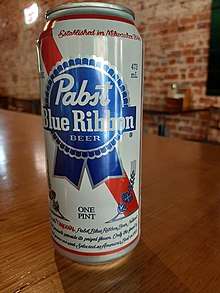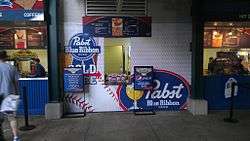Pabst Blue Ribbon
Pabst Blue Ribbon is an American lager beer sold by Pabst Brewing Company, established in Milwaukee, Wisconsin, in 1844 and currently based in Los Angeles. Originally called Best Select, and then Pabst Select, the current name comes from the blue ribbons tied around the bottle neck between 1882 and 1916.
 | |
| Type | American-style lager |
|---|---|
| Manufacturer | Pabst Brewing Company |
| Introduced | 1844 |
| Alcohol by volume | 3.8–6.5% Hard Coffee 5% Hard Seltzer 8% Whiskey 40%[1] |
| Website | pabstblueribbon |
History
Gottlieb and Frederika Pabst and their twelve-year-old son Frederick arrived in the United States in 1848 and settled in Chicago where Frederick eventually found work on the ships of Lake Michigan.[2] In 1862, Frederick married Maria Best, daughter of the founder and owner of the Best Brewing Company, and in 1863 became a brewer at his father-in-law's brewery.[3]
When Philip Best retired to Germany in 1867, Pabst and Emil Schandein - his sister-in-law's husband and the vice-president of Best Brewery - worked to transform the company into one of the nation's largest brewers, capitalizing on, among other things, the Great Chicago Fire of 1871 that destroyed nineteen Chicago breweries and helped position Milwaukee as the leading beer-producing city in the United States.[4] In 1889, Schandein died, leaving Pabst as president and his widow, Lisette Schandein, as vice-president.[5][6] In 1890, Pabst changed the "Best" letterhead to "Pabst" and the Pabst Brewing Company officially began.
This is the original Pabst Blue Ribbon Beer. Nature's choicest products provide its prized flavor. Only the finest of hops and grains are used. Selected as America's Best in 1893.
— Quote from PBR label, referring to the award it received at the 1893 World's Columbian Exposition.[7]
Brand name

The company has historically claimed that its flagship beer was renamed Pabst Blue Ribbon following its win as "America's Best" at the World's Columbian Exposition in Chicago in 1893. Whether the brand actually won an award in 1893 is unclear. Some contemporaneous accounts indicate that many vendors were frustrated by the fair's refusal to award such prizes. One account says that the only prizes awarded by the executive committee were bronze medals, in recognition of "some independent and essential excellence in the article displayed", rather than "merely to indicate the relative merits of competing exhibits". However, the beer had won many other awards at many other fairs – so many, in fact, that Captain Pabst had already started tying silk ribbons around every bottle. It was a time when beer bottles were more likely to be embossed than labeled and the ribbons were likely added at great cost to Pabst. But Pabst's display of pride was also a display of marketing savvy, as patrons started asking their bartenders for "the blue-ribbon beer."[8][9]
Peak, decline, and revival

Sales of Pabst peaked at 18 million barrels in 1977.[10] In 1980 and 1981, the company had four different CEOs, and by 1982 it was fifth in beer sales in the U.S., dropping from third in 1980.[11]
In 1996, Pabst headquarters left Milwaukee,[12] and the company ended beer production at its main complex there.[13] By 2001, the brand's sales were below a million barrels. That year, the company got a new CEO, Brian Kovalchuk, formerly the CFO of Benetton, and major changes at the company's marketing department were made.[14]
In 2010, food industry executive C. Dean Metropoulos bought the company for a reported $250 million.[15] In 2011, the U.S. Securities and Exchange Commission forced two advertising executives to cease efforts to raise $300 million to buy the Pabst Brewing Company. The two had raised over $200 million by crowdsourcing, collecting pledges via their website, Facebook, and Twitter.[16] In November 2014, Eugene Kashper, an American beer entrepreneur, and TSG Consumer Partners acquired Pabst Brewing Company.[17][18][19] In 2015, Pabst won the "best large brewing company of the year" award at the Great American Beer Festival.[20]
PBR is now available in several international markets, including Australia,[21] Canada,[22], Ukraine, Russia,[23] and China.[24]
Marketing

In the mid-1940s, the brand was the titular sponsor of the radio comedy show Blue Ribbon Town, starring Groucho Marx. It later was a sponsor of the radio mystery show Night Beat in the early 1950s.
The beer experienced a sales revival in the early 2000s after a two-decade-long slump, largely due to its increasing popularity among urban hipsters.[25][26] Although the Pabst website features user-submitted photography, much of which features twenty-something Pabst drinkers dressed in alternative fashions,[27] the company has opted not to fully embrace the countercultural label in its marketing, fearing that doing so could jeopardize the very "authenticity" that made the brand popular (as was the case with the poorly received OK Soda).[25][28][29] Pabst instead targets its desired market niche through the sponsorship of indie music, local businesses, facial hair clubs (RVA Beard League), post-collegiate sports teams,[30] dive bars and radio programming like National Public Radio's All Things Considered.[26][31] The company encourages the online submission of fan art, which is subsequently shown on the beer's official Facebook page.[32]
In popular culture
In the 1986 David Lynch film Blue Velvet, the character Frank Booth asks main character Jeffrey Beaumont for his favorite beer. Beaumont answers by saying Heineken, to which Booth gets infuriated; shouting "Pabst Blue Ribbon" at him.[33]
Pabst Blue Ribbon is sometimes featured in the popular TV show South Park.[34]
References
- "Products".
- Ogle, Maureen (2006). Ambitious Brew: The Story of American Beer. New York: Harcourt. p. 49. ISBN 0151010129.
- Ogle. Ambitious Brew. p. 51.
- Skilnik, Bob (2006). Beer: A History of Brewing in Chicago. Ft. Lee, N.J.: Barricade Books. pp. 24–25. ISBN 1569803129.
- The National Cyclopaedia of American Biography. J.T. White. 1893. p. 294.
- Mansion, The Pabst. "Pabst Brewery History". pabstmansion.com. Retrieved December 25, 2016.
- "The brewery's flagship beer was finally renamed Pabst Blue Ribbon following its win as 'America's Best' at the World's Columbian Exposition in Chicago". Retrieved August 9, 2010.
- Stamp, Jimmy. "Where Did Pabst Win that Blue Ribbon?". smithsonianmag.com. Retrieved December 25, 2016.
- Bancroft, Hubert Howe. The Book of the Fair: an historical and descriptive presentation of the world's science, art, and industry, as viewed through the Columbian Exposition at Chicago in 1893, designed to set forth the display made by the Congress of Nations, of human achievement in material form, so as to more effectually to illustrate the profess of mankind in all the departments of civilized life. Chicago, San Francisco: The Bancroft Company, 1893. p.83. (10 v. [approx., 1000p.]: illus. (incl. ports.), 41 cm.)
- Pabst Brewing Co. Timeline from the company's website
- Ray Kenney (January 24, 1982). "The Blue-Ribbon Battle for Pabst". The New York Times.
- Carrie Antlfinger (April 4, 2014). "Group Wants to Bring Pabst Blue Ribbon Back to Milwaukee". Associated Press. Retrieved April 5, 2014.
- Don Terry (November 6, 1996). "Brewery's Exit Leaves a Bitter Taste". The New York Times.
- Rob Walker (June 22, 2003). "The Marketing of No Marketing". The New York Times.
- "Pabst Brewing Sells Itself to Metropoulos". The New York Times. June 25, 2010.
- Michael J. De La Merced (June 8, 2011). "S.E.C. Stops Would-Be Buyers of Pabst Beer". The New York Times.
- Wilmore, James (November 14, 2014). "Pabst Brewing Co sale finalised as Eugene Kashper, TSG take reins". Retrieved November 14, 2014.
- Lockwood, Denise (November 14, 2014). "Pabst Brewing Co. sale completed, company to stay in Los Angeles". Milwaukee Business Journal.
- Gelles, David (November 18, 2014). "Hey Guys, the Russians Aren't Buying Pabst After All", New York Times. Retrieved March 14, 2016.
- Daykin, Tom (September 28, 2015). "Titletown and Pabst Gain National Awards at Great American Beer Festival", Milwaukee Journal Sentinel. Retrieved October 3, 2015.
- "Pabst Blue Ribbon Premium Lager Cans 473mL". Dan Murphy's Online. Retrieved January 8, 2014.
- "Pabst Blue Ribbon". pabstblueribbon.ca. Retrieved December 25, 2016.
- Евгений Депутат (April 15, 2018). ""Pabst Blue Ribbon" – американская лицензионная новинка из Радомышля". beerplace.com.ua. Retrieved May 16, 2020.
- Miller, Russell (2000). Doing Business in Newly Privatized Markets: Global Opportunities and Challenges.
- Rob Walker (June 22, 2003). "The Marketing of No Marketing". The New York Times. Retrieved September 17, 2009.
- "Marketing With a Whisper". Fast Company. January 11, 2003. Archived from the original on April 2, 2004. Retrieved November 1, 2009.
- "Pabst Blue Ribbon Homepage". Retrieved November 1, 2009.
- Carly Berwick (June 25, 2008). "Murketing to Hipsters Saves Pabst, Boosts Apple". Bloomberg. Archived from the original on January 18, 2013. Retrieved November 1, 2009.
- Edward McClelland (August 11, 2008). "And the next great American beer will be ... ?". Salon.com. Archived from the original on August 11, 2008. Retrieved September 17, 2009.
- "Pabst Blue Ribbon Lacrosse". Archived from the original on March 29, 2009. Retrieved November 16, 2009. PBR Lacrosse is the official lacrosse team of Pabst Blue Ribbon Beer. PBR Lacrosse is the premier post-collegiate lacrosse team in Houston, Texas. The team is made up of post-NCAA Division I, II and III and MCLA players. They compete against SWLA teams throughout the state of Texas and play in tournaments in the southern United States region.
- Dan Eaton (November 16, 2008). "Pabst gives marketing campaign a blue ribbon for effectiveness". Columbus Business First. Retrieved November 1, 2009.
- "Facebook". facebook.com. Retrieved December 25, 2016.
- Brion, Raphael (June 1, 2010). "Dennis Hopper's Beer Wisdom from Blue Velvet". Eater.
- "The Poor Kid" – via www.imdb.com.
External links
- Official website
- A souvenir booklet from the Pabst Brewing Company, 1907, Wisconsin Historical Society